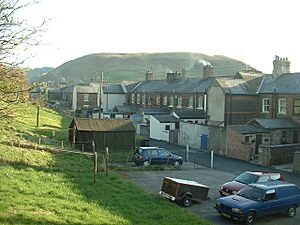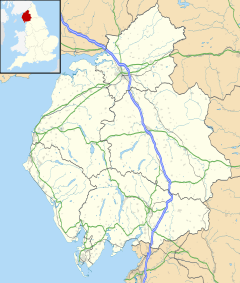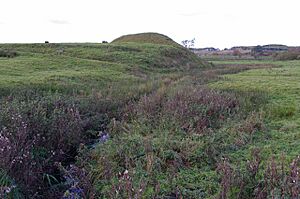Tebay facts for kids
Quick facts for kids Tebay |
|
|---|---|
 Railway cottages |
|
| Population | 776 (2011) |
| OS grid reference | NY618045 |
| Civil parish |
|
| District | |
| Shire county | |
| Region | |
| Country | England |
| Sovereign state | United Kingdom |
| Post town | PENRITH |
| Postcode district | CA10 |
| Dialling code | 01539 |
| Police | Cumbria |
| Fire | Cumbria |
| Ambulance | North West |
| EU Parliament | North West England |
| UK Parliament |
|
Tebay is a small village in Cumbria, England. It's located in a beautiful valley called the Lune Valley. This area is known as the Lune Gorge. In 2011, about 776 people lived in Tebay.
Just north of Tebay is a place called Old Tebay. This area was once mainly used for sheep farming. When the railway arrived, it brought more jobs and helped the village grow.
Contents
Exploring Tebay's Past
Ancient History and Roman Roads
Near the River Lune, you can find the remains of an old castle called Castle Howe. It was a motte and bailey castle. This type of castle had a mound (motte) with a tower and a walled area (bailey). It was built in a good spot to protect the area.
Long ago, during the time of the Romans in Britain, a Roman road followed the River Lune. This road connected Roman forts. One fort was at Low Borrowbridge, near Tebay. Another was at Over Burrow to the south. A newer discovery, found using special technology called LIDAR, showed another Roman road. This road linked the fort at Low Borrowbridge to a fort further north at Kirkby Thore. From there, it went towards Hadrian's Wall.
The 'Witch of Tebay'
Tebay was once home to a woman named Mary Baynes. She was known as the 'Witch of Tebay'. She was a prophetess, which means people believed she could see the future. Mary Baynes passed away in 1811.
How Tebay Became a Parish
Historically, Tebay was a small part of the larger area of Orton. It was called a township. In 1897, Tebay became its own separate civil parish. This meant it had its own local government.
Travel and Transport in Tebay
The Importance of Railways
Tebay railway station was an important stop on the Lancaster and Carlisle Railway. This railway line was built between 1844 and 1846 to connect the cities of Lancaster and Carlisle. Later, it became part of a bigger railway company.
Tebay became a key railway junction. In 1861, the Stainmore Railway opened. This line connected Tebay to places like Kirkby Stephen and Barnard Castle in the east. It closed in 1962. Today, the A685 road follows much of its old path. Another railway line, the Ingleton Branch Line, also connected to the main line near Tebay. It was used for passengers until 1963.
The railway companies created many jobs for people in Tebay. This led to new houses being built for the growing population.
Sadly, there have been two railway accidents near Tebay. On 15 February 2004, an accident involving a maintenance vehicle occurred. Three years later, on 23 February 2007, the Grayrigg rail crash happened between Oxenholme and Tebay.
Major Roads Near Tebay
Junction 38 of the M6 is just west of Tebay. This part of the M6 is near the challenging Shap Summit. Like the railway, the motorway uses the Lune Valley to pass through the hills.
A famous stop nearby is Tebay Services. It's about a mile northwest of the village. This service station is special because it's one of the few that are run independently. It's often praised for its good food.
Life in Tebay Village
The Railway Club is a central part of the village. It reminds everyone of how important the railway used to be. The Cross Keys pub is another place where people in the village can meet and relax.
In the past, many people in Tebay worked for the railway. The local Junction Hotel, which once had dance halls, is now used as flats.





